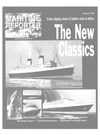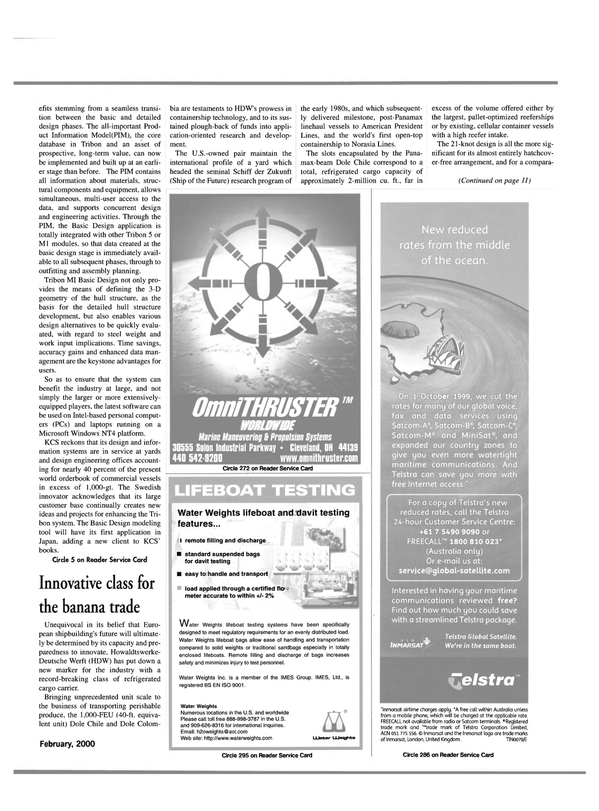
Innovative class for the banana trade
Unequivocal in its belief that European shipbuilding's future will ultimately be determined by its capacity and preparedness to innovate, Howaldtswerke- Deutsche Werft (HDW) has put down a new marker for the industry with a record-breaking class of refrigerated cargo carrier.
Bringing unprecedented unit scale to the business of transporting perishable produce, the 1,000-FEU (40-ft. equivalent unit) Dole Chile and Dole Colom- bia are testaments to HDW's prowess in containership technology, and to its sustained plough-back of funds into application- oriented research and development.
The U.S.-owned pair maintain the international profile of a yard which headed the seminal Schiff der Zukunft (Ship of the Future) research program of the early 1980s, and which subsequently delivered milestone, post-Panamax linehaul vessels to American President Lines, and the world's first open-top containership to Norasia Lines.
The slots encapsulated by the Panamax- beam Dole Chile correspond to a total, refrigerated cargo capacity of approximately 2-million cu. ft., far in excess of the volume offered either by the largest, pallet-optimized reeferships or by existing, cellular container vessels with a high reefer intake.
The 21-knot design is all the more significant for its almost entirely hatchcover- free arrangement, and for a compara- tively tender, maximum draft of 33 ft.
(10.2-m), features reflecting the operating requirements of Dole Fresh Fruit International. The open-top configuration and associated, raised cellular structure; adopted throughout the cargo section bar the furthest forward. No. I hold, promote faster turnarounds of the gantry crane-equipped vessels on their Central America-U.S. Eastern Seaboard service pattern. It also offers distinct advantages as regards heat dissipation from the cargo holds, given the considerable amount of heat given off the reefer equipment integral to the cold storage containers. The investment in the bespoke newbuilds by Dole, reckoned to be the world's largest shipper of fresh fruit and vegetables, has been made against a backcloth of strong brand demand and planning for business expansion. The introduction of the two 30,560-dwt vessels, which will be used mainly for northbound movements of bananas, is central to a strategy of realizing new transportation efficiency goals, and reducing reliance on chartered tonnage.
While considerations of the dependability of supply permeate the latest fleet project, the U.S. operator's parallel preoccupation with cargo care is manifested in the modified atmosphere (MA) arrangements adopted in the two ships.
Dole and the HDW-built sisters' classification society Germanischer Lloyd have substantial experience of both MA and controlled atmosphere (CA) methods, whereby the produce is subjected to a nitrogen-rich environment. This has the effect of retarding the ripening process, so as to prolong product life and ensure that fruit reaches the consumer in peak condition throughout the year.
Circle 6 on Reader Service Card
Read Innovative class for the banana trade in Pdf, Flash or Html5 edition of February 2000 Maritime Reporter
Other stories from February 2000 issue
Content
- Bergesen Orders Four Tankers From Hitachi page: 7
- Chuan Hup Unit Secures PB Contract page: 7
- A model approach from the Swedes page: 8
- Innovative class for the banana trade page: 9
- Propeller Milestone Achieved By U.S. Navy page: 10
- Propeller & Shafting Symposium Planned page: 11
- PropacRudder Benefits Confirmed In Service page: 12
- E&P Spending 2000: Boom or Bust? page: 14
- New Government Statistics Show Larger, Diverse Fleet page: 15
- ATB Delivered by Alabama Shipyard page: 16
- Cruise Shipping Annual The New "Class" of Celebrity's Class page: 19
- Cunard Creates The Classic Liner (Again) page: 24
- Cruise Industry Leaders To Convene At SeaTrade page: 25
- Cruise Share Performance page: 26
- Litton Marine Systems Supplies IBS Order page: 27
- MSC Europe Experiencing Steady Growth Stream page: 27
- James P. Colie Completes Cruise Ships Refurbish page: 29
- New Cruise Ship Designs Impact Terminal Ops And Logistics page: 31
- Royal Caribbean Commits To Environmental Endeavors page: 34
- Superseacat Service To Be Launched page: 35
- Strong Finish To A Strong Year In Oslo page: 37
- New MaK M 43 Series Aids German Branch page: 38
- Isotta Fraschini Marine Diesel Engines Available on W. Coast page: 38
- DeJong & Lebet Assists On Vessel Conversion page: 40
- Coastal AIS Stations with Radars: High-Efficiency Monitoring Facility page: 44
- Supporting The Technical Revolution page: 46
- Cadkey 99 Offers Powerful Features page: 48
- Where Businesses And Consumers Can Mix page: 48
- BT Unveils E-Commerce Site page: 48
- Finnish Innovation Ascends New Heights page: 50
- AKER FINNYARDS page: 50
- Keeping Machinery Spaces Safe page: 53
- Kvaerner Masa-Yards Delivers page: 54
- Record Trade Surplus Boosted By Shipsales page: 55
- Allied Systems Delivers SOLAS Approved Davit page: 55
- GDHS Launches Friobox Express page: 56
- Schoellhorn-Albrecht Supplies Deck Equipment page: 58
- Golden Ocean Reaches Agreement; Announces Resignation page: 58
- GD Appoints Welch As Snr. VP page: 60
- Furuno Introduces CH-37 Sonar page: 60
- STN Introduces New Speed Log page: 60
- NASSCO Lands First Phase Of Ship Conversion page: 65
- Derecktor Shipyard Wins Contract For Two Pilot Boats page: 66
- Gladding-Hearn to Deliver Largest Incat Fast Ferry page: 67
- Bollinger Launches Ocean Intervention II page: 70
- SeaArk Delivers Commander To Passaic Valley page: 70


